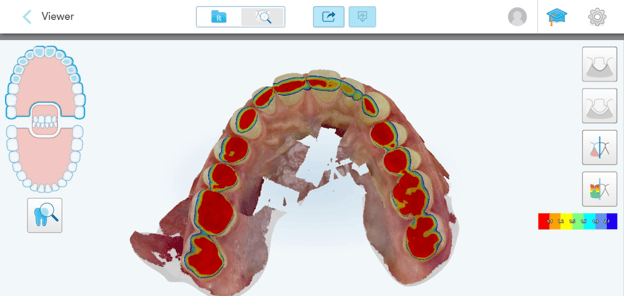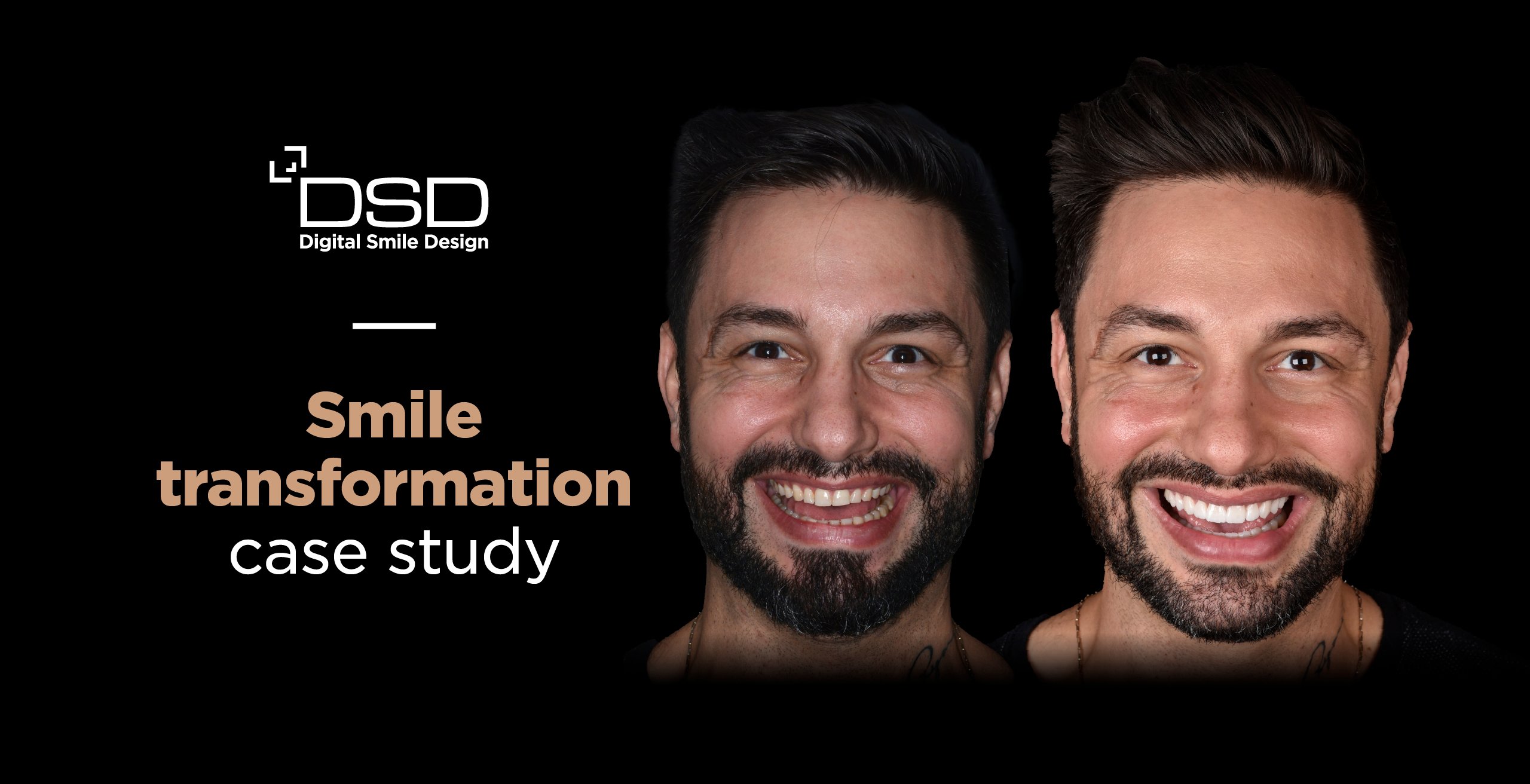Quick esthetic and functional solution after defining the new vertical dimension
Digital Smile Design offers clinicians the ability to treatment plan to an exceptional standard in complex restorative cases with predictable outcomes. In this case study, we discuss the steps taken to achieve this patient’s high-impact smile transformation. Prior to treatment, the patient’s main concern was the lack of vertical height in the anterior teeth.
Initial clinical diagnosis
- Upper and lower tooth wear
- Altered smile curve
- Occlusion alteration
This case was planned by the DSD Planning Center in Madrid, giving the patient the optimal treatment in a short amount of time to achieve improved function and esthetics. The treatment was performed live during the DSD Residency 2 course in Sao Paulo, Brazil.
The treatment plan involved the following:
1. Digitalization of the patient and digital planning of the case
2. Patient motivation with DSD Mock up® and presentation of the treatment plan
3. Transitional restorations with DSD Direct® addressing the vertical dimension and using it as an esthetic test for the patient
4. Final ceramic veneers and tabletops
Treatment timeline
At the first appointment, the patient explained what made him uncomfortable about the appearance of his teeth, specifically their height. The first step was the patient digitalization following the DSD Photo Protocol, in addition to CBCT scans and intraoral scans using the iTero® Element 5D. With the multidisciplinary expertise of the DSD Planning Center in Madrid, the treatment plan involved several stages, to give this patient a restored smile with improved function and esthetics.
At the following appointment the patient had a smile preview with the motivational mockup and treatment presentation of the proposed treatment plan which featured a bite lift, vertical dimension increase using the DSD Direct technique in the upper and lower arches and final ceramic restorations.
The patient was happy with the suggested course of action and accepted all proposed treatment. A DSD Anterior Deprogrammer (which was digitally designed and manufactured with a 3D printer at DSD Laboratory) was applied, after which the bite was rescanned in the new final vertical dimension to plan the DSD Direct silicone indices. Then the DSD Direct technique was clinically performed, the occlusion adjusted and registered with the iTero intraoral scanner.
The next appointment took place at the following DSD Residency 2 course where the preparation of the teeth was performed with the digitally designed guides based on the final result and printed using 3D printing technology. And after 2 days, the final restorations were cemented in.
The treatment plan involved the following techniques, devices and workflows:
- Smile test drive
- DSD Anterior Deprogrammer
- DVO Increase
- DSD Direct
- DSD Natural Restorations®
Case highlights
 “This case involved a number of innovative steps that all contributed to a naturally esthetic end result that the patient was very happy with. These stages included the DSD Mock Up, the DSD Anterior Deprogrammer, DSD Direct, the iTero Element 5D imaging system, 3D restoration preparation guides and the DSD Natural Restorations,” explains Luken de Arbeloa, DSD Education Strategy Director.
“This case involved a number of innovative steps that all contributed to a naturally esthetic end result that the patient was very happy with. These stages included the DSD Mock Up, the DSD Anterior Deprogrammer, DSD Direct, the iTero Element 5D imaging system, 3D restoration preparation guides and the DSD Natural Restorations,” explains Luken de Arbeloa, DSD Education Strategy Director.
- DSD Mock up
“The DSD Mock up remains one one of the most effective ways to demonstrate to a patient the life-changing impact their dental treatment can have. I believe it offers patients the best way to test drive their new smile before treatment starts, giving them the opportunity to truly experience how it would feel. It is a powerful communication tool,” de Arbeloa continues.
- DSD Anterior Deprogrammer
“The digitally designed and 3D printed DSD Anterior Deprogrammer is an excellent treatment option to deprogram the patient; for me, it’s the perfect mix of a traditional concept using the new technology,” he explains. “Adapted for digital workflows by DSD, the deprogrammer is a removable, plastic appliance that covers the hard palate and creates a single point of contact between the lower central incisor and the anterior bite plane. It can be used by clinicians to evaluate bite stability, to locate a patient’s optimal jaw position and to diagnose the type of abnormal occlusal attrition.”
- DSD Direct
“As a transitional restoration for a predictable esthetic and functional test drive, I always recommend using DSD Direct,” he explains. “This product helps dentists to avoid having to rely on time-consuming and inconsistent freehand composite veneering techniques. The DSD Direct injectable composite guides are 3D printed and ensure predictable esthetic outcomes for every case. With this particular patient, the upper and lower composite veneers gave an esthetic improvement to tooth length, as well as spacing between the teeth,” he added.
- iTero intraoral scanner
“A powerful imaging system like the iTero Element 5D was a very helpful tool to use in this case, as accurate scanning was required at several stages of treatment to prepare the following phase. It was used for the initial scan, the new vertical dimension scan and for the tooth preparation for the final ceramic restoration, which ensured that treatment was precise and delivered to the standard that was detailed in the treatment plan,” he continues.

- Preparation guides
“Another outstanding element of this case was the preparation guides that were used before the final ceramic veneers were placed. These state-of-the-art appliances are designed digitally and 3D printed for guided and controlled tooth preparations, ensuring the highest level of accuracy, conservative tooth preparation, optimal treatment time and patient comfort,” he adds.
- DSD Natural Restorations
“Finally, after the teeth were prepared, the case was concluded with the fitting of DSD Natural restorations ceramic veneers, giving the patient a final restoration with natural textures and life-like translucency with the renowned DSD copy paste concept,” he says. “This case brings together all the elements of the latest technology, interdisciplinary treatment planning and robust workflows to give the patient a smile that truly reflects his personality and allows his confidence to shine through.”
Patient comment
“I’ve always had a lot of trouble with tartar that accumulated on my teeth, not to mention that my teeth are small. I think they were wearing out and they are small compared to normal teeth. This bothered me. They were small and this bothered me more than anything else. This procedure fills the entire dental arch, I think, and I think it has made a good difference. The result is very nice! I didn’t think it would look this good. I think it is better than I imagined. Very, very good. I’m very happy! The end result is impressive!”
This case was an interdisciplinary collaboration between Christian Coachman, Drs Jacqueline Schneider, Ricardo Brito and Marcelo Calamita.
To learn more about DSD's clinical solutions and gain new insights into your clinical performance, patient experience and teamwork, you may benefit from attending a DSD Residency 1 course. Take a look at our in-person and online programs here.
Photos by Dr. Jesus Creagh and the DSD Planning Center




